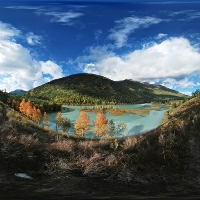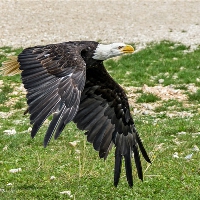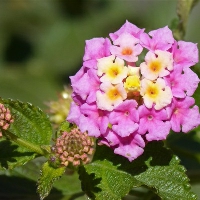一本教会你“做对”题的6级阅读书 day3 passage2
Passage 2 Bubbles of the Future?
如何俘获发电厂排放出的二氧化碳? 《新闻周刊》2009-11-25 049
Bubbles of the Future?
Carbon sequestration sounds like a perfect solution to America's energy misfortune:
capture carbon dioxide emitted by power plants in the atmosphere
and store it deep in the ground.
But as the technology to perfect carbon sequestration advances,
it continues to face an unpleasant source of opposition: environmentalists.
From West Virginia to New Jersey to Germany,
green groups are protesting carbon capture and sequestration (CCS) projects,
citing concerns over safety and effect. They insist that accepting CCS
only allows energy companies to "greenwash" an inherently dirty practice,
giving those companies an excuse to avoid the painful
but necessary switch to renewable energy sources like wind and solar.
[01:03]There are nearly 200 such projects in various stages of development around the world,
[01:10]according to the U.S. Department of Energy.
[01:14]The federal stimulus bill set aside $3.4 billion for CCS research, and the government
[01:23]has offered at least $8 billion in loan guarantees
[01:27]for coal-fired power plants that employ CCS technology.
[01:33]?Opponents of CCS, which include Greenpeace and the Sierra Club,
[01:39]insist that this particular approach to pollution lessening is cheating.
[01:45]By some estimates, current technology will require
[01:50]between 10 and 40 percent of a plant's power just to function,
[01:55]and there's no guarantee that the carbon will stay still.
[01:59]If even a fraction of injected CO2 leaks out from underground storage sites,
[02:05]it could trigger a chain of chemical reactions that would cause poisons
[02:11]to the water supply, before eventually making its way back into the atmosphere
[02:16]where it would continue to warm the planet.
[02:20]And the technology might not be ready for large-scale deployment until 2030—
[02:26]about 15 years too late to avoid the worse effects of man-made global warming,
[02:34]according to many experts. Better to invest that money in renewable energy,
[02:39]opponents argue, than to waste it improving coal-fired power plants,
[02:44]which will presumably be obsolete in the coming decades anyway.
[02:49]Those are all valid concerns. But, as CCS proponents point out,
[02:55]more than two billion tons of domestic CO2 emissions come from existing coal-
[03:01]fired power plants. That accounts for half of total U.S. annual CO2 emissions.
[03:09]So even if we never build another coal-fired plant again,
[03:14]any hope of tackling climate change will require us to deal with the emissions
[03:20]from those existing plants, advocates say.
[03:24]"Obviously, we'd rather see more energy efficiency and more renewable energy,
[03:31]" says Natural Resource Defense Council (NRDC) scientist George Peridas.
[03:38]"But I think we have to be realistic. I haven't seen any convincing evidence
[03:45]that we're going to completely eliminate the use of fossil fuels in the coming years,
[03:51]so we have to figure out how to eliminate—or at least reduce—emissions."
[03:57]The opportunities are particularly ripe in some countries,
[04:01]where electricity consumption has shot up in the recent years.
[04:06]The countries still meets about 60-70 percent of their energy needs with coal,
[04:13]making them some of the world's largest emitters of CO2.
[04:19]According to a recent NRDC report, lower labor, material,
[04:25]and fuel costs will make CCS cheaper in the countries. Higher concentrations of CO2
[04:33]and natural geology contributive to carbon storage
[04:37]would also lower the cost of CCS projects in the regions.
[04:42]While CCS still has a way to go before it's ready for large-scale deployment,
[04:49]it might not take as long as opponents imply.
[04:52]Earlier this year Energy Secretary Steven Chu wrote in the journal Science that
[05:00]"widespread deployment of CCS can begin in 8 to 10 years." For example,
[05:06]amine cleaning—where chemicals are used to separate CO2 from natural gas
[05:12]and hydrogen—has been used since 1930 to remove CO2 from the air aboard submarines
[05:20]and spacecraft. Experts say the technology is robust, proven,
[05:27]and ready to be tested on a larger scale for CO2 capture from coal-fired plants.
[05:34]And in the past year, scientists at Columbia University have made significant progress
[05:41]absorbing CO2 out of the air with the use of synthetic trees.
[05:47]Opponents remain unconvinced. "To combat climate change, the scale of CCS operations
[05:55]would need to be tremendous," says Greenpeace spokesperson Emily Rochon.
[06:02]"We have a lot left to learn about CO2 storage, and the corporations in charge of
[06:09]such projects aren't always acting in the most responsible manner possible."
[06:16]It's true that without more large-scale pilot projects people won't know for certain
[06:23]how safe or effective CCS is. But some early research looks promising enough to justify
[06:32]further study. For example,
[06:35]a 2005 report by the International Panel on Climate Change (IPCC)
[06:40]found that if CCS projects were properly sited and regulated,
[06:48]geological reservoirs could retain 9 percent of the carbon injected
[06:53]by CCS for hundreds to thousands of years. Studies show that the CO2
[07:00]will react with some elements in rocks to form calcium carbonate,
[07:04]essentially making the carbon part of the rock itself.
[07:09]And some experts believe that if proper limits were observed,
[07:15]liquid CO2 could be injected into the deep sea or the ocean floor
[07:21]without adversely impacting the local ecosystem,
[07:24]offering a potential reservoir for hundreds of billions of CO2.
[07:29]While CCS is expensive, there is no reason to believe that
[07:36]this technology won't follow the same trend as wind and solar—
[07:41]as the scale of projects increases, cost reductions will become apparent.
[07:48]American Electric Power, the nation's largest electricity producer, seems to think so.
[07:55]The company recently spent $73 million to improve its coal-
[08:01]fired "Mountaineer" power plant in New Haven, West Virginia,
[08:06]with wells and a small chemical factory that can covert CO2 into liquid
[08:12]and then inject it 8,000 feet underground. The plant now captures
[08:17]about 1.5 percent of its own emissions. But the company told The New York Times in September
[08:26]that if Congress passes a law controlling CO2 emissions, it would move to capture more—
[08:32]as much as 90 percent more—of the CO2 emitted from the Mountaineer plant. Duke Energy,
[08:40]a plant under construction in Edwardsport, Indiana, has been designed
[08:45]with extra space to allow for eventual improving with CCS equipment.
[08:51]But Duke will wait for Congress to act before the company begins any actual CCS projects.
[08:59]"We need to know what the price of carbon is going to be
[09:02]before we make any long-term capital plans," says Duke Energy spokesman Lew Middleton.
[09:11] The climate-change bill passed by the House of Representatives
[09:15]on June 26 requires all coal plants given permits after 2020 to use CCS
[09:23]when they begin operating, and all plants approved after 2009 to improve within five years.
[09:31]The Senate version of the bill, which is expected to be taken up in 2010,
[09:36]sets emission standards for coal-fired plants approved after 2009 but does not pass CCS.
[09:45]Proponents of CCS hope that if an international agreement
[09:50]on reduction targets is made in Copenhagen, companies might be compelled to work
[09:56]across borders on technology transfer. It won't be a remedy for difficulties,
[10:01]but at least it's a start.
 春夏秋冬 2022-09-22 20:12:40
春夏秋冬 2022-09-22 20:12:40









